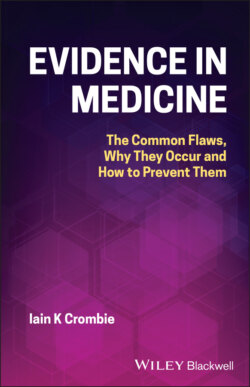Читать книгу Evidence in Medicine - Iain K. Crombie - Страница 12
CASTING LOTS AND TREATMENT ALLOCATION
ОглавлениеComparing similar groups of patients was an important step forward in the evaluation of treatments, but it leaves open the possibility that the groups may have differed on important factors that were not measured. Further, a subconscious bias in the doctor allocating patients to treatments could influence the way individuals were assigned to groups (e.g. the slightly sicker ones might be preferentially assigned to one group). An alternative approach, which prevents this bias, is to allocate individuals to treatments in a truly random way, so that the final groups will be balanced on all factors, whether measured or not.
The idea that some form of randomisation should be used to allocate patients to treatment groups was proposed in the 1640s. Joan Baptista van Helmont, a Flemish chemist, alchemist and physician, recommended this method to evaluate the effectiveness of bloodletting [33]. He suggested dividing up to 500 patients into 2 groups, then casting lots (equivalent to tossing a coin) to decide which group would be given the conventional therapy (bloodletting) and which would receive van Helmont's own treatment. A notable feature of the trial design is that the outcome would be decided by the number of funerals that occurred in the two groups. The experiment was not carried out. (The proposed use of an objective outcome measure such as this is unusual for its time.)
One method of randomised allocation was used in 1848 by Thomas Graham Balfour to investigate whether homeopathic belladonna could prevent scarlet fever. Balfour identified 151 boys who had not had the disease, and ‘divided them into two sections, taking them alternately from the list, to prevent the imputation of selection’ [34]. Balfour recognised that if he had to decide which boys were allocated to each group, his choices might be biased. (Alternate selection from a list is essentially a method of randomisation, as the factors which are related to dying from scarlet fever, will be randomly scattered throughout the list.) The study showed that exactly two children in each group developed scarlet fever, leading him to conclude that ‘the numbers are too small to justify deductions as to the prophylactic power of belladonna’ [34], a commendably careful interpretation of the findings.
Instead of alternate selection from a list, patients could be allocated to treatments by the date of their admission to hospital. This method was used by the Danish physician Johannes Fibiger in 1896–1897 [35] to evaluate the effectiveness of a serum treatment for diphtheria. Thus, patients admitted to hospital on one day received serum and those on the next day were untreated. The outcome was persuasive: only 8 of 239 patients in the serum group died, compared to 30 of the 245 controls.
The use of alternate allocation began to gain popularity in the first few decades of the twentieth century because it prevented bias in the assignment of patients to treatments. These research studies were conducted in both the United States and the UK, with patients being randomised by the order of their attendance at a healthcare facility [36–39]. These trials signalled the growing recognition of the importance of achieving comparable groups.
